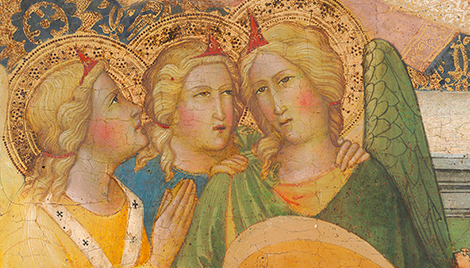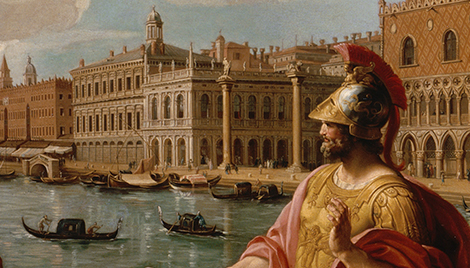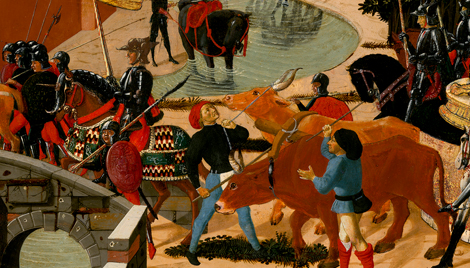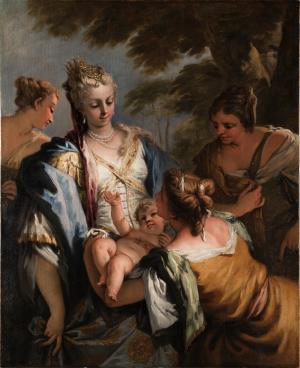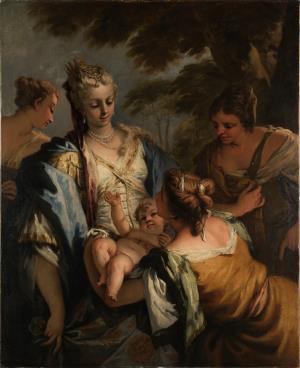The Finding of Moses
The Finding of Moses
- Artist
- Sebastiano Ricci
- Artist Dates
- 1659-1734
- Artist Nationality
- Italian
- Title
- The Finding of Moses
- Date
- c. 1710
- Medium
- oil on canvas
- Dimensions
- 131.8 x 106.7 cm (51-7/8 x 42 in)
- K Number
- K1703
- Repository
- Memphis Brooks Museum of Art
- Accession Number
- 61.204
- Notes
-
Traditionally paired with K1704, Jephthah and his Daughter, the two paintings have little in common apart from their identical English country house frames.
Provenance
Commissioned by Mr. Cristopher Crowe, Kiplin,Yorkshire. C. Turnor Stoke Rockford, Grantham, England. (Arturo Grassi, New York) in 1948. (Ars Antiqua, Inc., New York); sold to the Samuel H. Kress Foundation on 4 April 1950; gift 1961 to the Memphis Brooks Museum of Art, no. MBMA 61.204.
Catalogue Entry
Sebastiano Ricci
The Finding of Moses
K1703
Memphis, Tenn., Brooks Memorial Art Gallery (61.204 and 61.205, respectively), since 1958.(1) Canvas. 51 7/8 x 42 in. (131.8 x 106.7 cm.) and 52 5/8 x 43 1/8 in. (133.6 x 109.5 cm.), respectively. Very good condition. These two paintings, which may well have been intended as pendants, are accepted as examples of Ricci's style of about 1710, as developed under the strong influence of Veronese. It has been suggested that for K1703 Ricci may have had in mind one of the versions of a picture of the same subject by Veronese, most likely the version now in the Dresden Gallery.(2) Veronese's figures are full-length, yet his types of women are echoed in the figures in K1703. A seemingly more mature development of the type used in K1703 for Pharaoh's daughter appears in full-length as St. Elizabeth in a beautiful picture by Ricci discovered a few years ago in the collection of Antonio Marchi, Parma.(3) The subject of K1703 is taken from Exodus 2:9, and that of K1704, from Judges 11:34. Provenance: Mr. Crowe, Yorkshire, commissioned by him (according to tradition). C. Tumor, Stoke Rockford, Grantham. Dr. Arturo Grassi, New York –exhibited: 'A Gallery of Eighteenth Century Venetian Paintings,' J. B. Speed Art Museum, Louisville, Ky., June 2-29, 1948, nos. 20 and 21, as Ricci. Ars Antiqua, New York. Kress acquisition, 1950 –exhibited: Philadelphia Museum of Art, 1950-53;(4) 'Sebastiano and Marco Ricci in America,' Brooks Memorial Art Gallery, Memphis, Tenn., Dec. 19, 1965-Jan. 23, 1966, and University of Kentucky Art Gallery, Lexington, Ky., Feb. 13-Mar. 6, 1966, nos. 10 and 11 of catalogue by M. Milkovich, as Ricci.
References
(1) Catalogue by W. E. Suida, 1958, pp. 44 ff., and by M. Milkovich, 1966, pp. 52 ff., as Ricci. (2) This version was presumably in Venice until 1747, when the Dresden Gallery acquired it from the Casa Grimani de' Servi. Suida (loc. cit. in note 1, above) suggests Ricci's dependence on the Dresden Veronese. Suida's suggestion is repeated by Milkovich (loc. cit. in note 1, above, and in loc. cit. in Provenance, suggesting a date of c. 1705-12 for both K1703 and K1704). G. M. Pilo (in Arte Veneta, vol. XX, 1966, p. 305) also notes the influence of Veronese in K1703 and dates both pictures in the first decade of the eighteenth century. It has been noted that Ricci made free copies after Veronese: A. Blunt (in Burlington Magazine, vol. LXXXVIII, 1946, p. 264, pl. 111, D) publishes Ricci's free variant (now at Hampton Court) of the Prado version of Veronese's Finding of Moses, and F. J. B. Watson (in Id., vol. XC, 1948, p. 290) describes how Consul Smith, who sold the Ricci variant (along with the whole Smith Collection) to George III in the mid-eighteenth century, passed off the Ricci variant as a Veronese. See also M. Levey, Later Italian Pictures in the Collection of Her Majesty the Queen, no. 647, pl. 94. (3) Published by A. G. Quintavalle, in Arte Antica e Moderna, nos. 13-16, 1961, pp. 448 f., pl. XI. (4) Suida, in Philadelphia Museum Bulletin, vol. XLVI, 1950, pp. 18 ff., as Ricci.

